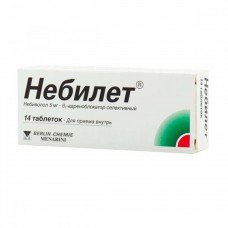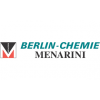Expiration date: 05/2027
Composition and form of release:
Tablets. 1 tablet contains:
nebivolol hydrochloride 5, 45 mg
(corresponds to 5 mg nebivolol)
excipients: lactose monohydrate corn starch MCC silicon magnesium dioxide stearate Polysorbate 80 hydroxypropylmethylcellulose sodium salt carboxymethylcellulose
in a blister 7 or 14 PCs. the box contains 1, 2 or 4 blisters.
Description of the dosage form:
Round, biconvex tablets of almost white color, with a one-sided notch for division.
Characteristic:
Cardioselective beta1-adrenoblocker.
Pharmacological action:
Lowers the increased blood PRESSURE at rest, during physical stress, stress. Competitively and selectively blocks synaptic and non-synaptic beta1-adrenoreceptors, making them inaccessible to catecholamines, modulates the release of endothelial vasodilating factor (NO).the Hypotensive effect is also due to a decrease in the activity of the renin-angiotensin system (does not directly correlate with changes in the activity of renin in blood plasma). In the first days of treatment, the OPSS increases, and later, with prolonged use, it normalizes or decreases. Hypotensive effect develops in 2-5 days, stable effect is observed in 1-2 months. Reduces the need for oxygen in the myocardium (heart rate reduction and reduction of pre-and post-loading), reduces the number and severity of angina attacks and increases exercise tolerance. The antiarrhythmic effect is caused by the suppression of the pathological automatism of the heart (including in the pathological focus) and the slowing of AV conduction.
Pharmacokinetics:
After ingestion, it is rapidly absorbed from the gastrointestinal tract (food intake does not affect absorption). Bioavailability — 12% in individuals with " fast "(the effect of" first passage "through the liver) metabolism and almost complete — in individuals with"slow". Binding to proteins for D-nebivolol — 98, 1%, for L-nebivolol-97, 9%. it is Metabolized to form active metabolites by acyclic and aromatic hydroxylation and partial N-dealkylation. the resulting hydroxy and amino derivatives are conjugated with glucuronic acid and are excreted as O - and N-glucurones. T1 / 2 hydroxymetabolites — 24 h, nebivolol enantiomers-10 h (for individuals with " fast "metabolism) for individuals with "slow" - 48 h and 30-50 h, respectively. It is excreted by the kidneys (38%) and intestines (48%).
Indications:
Arterial hypertension, CHD.
Contraindications:
Hypersensitivity, bronchial asthma, heart failure (in the decompensation stage), severe liver function disorders, arterial hypotension, severe bradycardia, cardiogenic shock, sinus node weakness syndrome, AV block II and III degrees, pheochromocytoma, Prinzmetal angina, depression, obliterating peripheral vascular diseases ("intermittent" claudication), myasthenia gravis, muscle weakness, age up to 18 years (efficacy and safety are not guaranteed installed).
Use during pregnancy and lactation:
During pregnancy and lactation should be used with caution, according to strict indications, under the supervision of a doctor.
Side effect:
Headache, dizziness, fatigue, paresthesia (frequency of occurrence 1-10%), nausea, dry mouth, diarrhea or constipation (more than 1% of cases). Bradycardia, orthostatic hypotension, heart failure, edema, cardiac arrhythmia, Raynaud's syndrome, AV block, cardialgia, depression, decreased attention, drowsiness, insomnia, "nightmarish" dreams, hallucinations, allergic reactions, photodermatosis, hyperhidrosis, bronchospasm (including in the absence of previously obstructive lung diseases), rhinitis.
Drug interaction:
Combination with anaesthetic agents causes a cardiodepressive effect and increases the risk of hypotension. When used simultaneously with hypotensive agents, nitroglycerin, blockers of "slow" calcium channels, sharp arterial hypotension may develop (special care should be taken when combined with prazosin) with antiarrhythmic agents, reserpine, alpha-methyldopa, clonidine, guanfacine — increased severity of bradycardia with cardiac glycosides — summation of the Chrono - and dromotropic effect with clonidine — increased "withdrawal"syndrome.
Inducers of microsomal oxidation (rifampicin, barbiturates) lower, and inhibitors (cimetidine) increase the concentration in blood plasma.
Dosage and administration:
Inside, regardless of food intake, with a sufficient amount of liquid, at the same time of day. The average daily dose is 2, 5-5 mg. Take 1 time a day. Patients with renal insufficiency or patients over 65 years of age are recommended at an initial dose of 2, 5 mg/day, if necessary, the daily dose can be increased to 10 mg.
Overdose:
Symptoms of beta-blocker overdose: low blood PRESSURE, nausea, vomiting, cyanosis, sinus bradycardia, AV block, heart failure, cardiogenic shock, cardiac arrest, bronchospasm, loss of consciousness, coma.
In clinical practice, overdose phenomena were not observed.
Treatment: gastric lavage, administration of activated charcoal, in case of severe hypotension, bradycardia and heart failure-intravenous administration of beta-adrenostimulants at intervals of 2-5 minutes until the desired effect is achieved. In the absence of effect — dopamine, dobutamine, norepinephrine. Then 1-10 mg of glucagon, setting up a transvenous intracardial stimulator. In case of bronchospasm-intravenous administration of beta2-adrenoreceptor stimulators. For ventricular extrasystole — lidocaine (class IA drugs are not used). For convulsions-intravenous administration of diazepam.
Precautionary measures:
In patients with angina, therapy should be discontinued gradually — within 1-2 weeks. With angina pectoris, the recommended dose should provide a heart rate at rest within 55-60 beats per minute, with a load of no more than 110 beats per minute. In smokers, the effectiveness of the drug is lower. With caution, it is used for kidney failure, in the elderly (over 65 years), diabetes mellitus (possible masking of signs of a decrease in blood glucose — nervousness, trembling, palpitation), with hyperfunction of the thyroid gland (masked increase in heart rate), with a tendency to allergies (possible increase in anaphylactic reactions). When psoriasis is prescribed only after a thorough analysis of the relationship between the possible risk and benefit of the drug.
Monitoring of patients taking the drug includes monitoring of heart rate and blood PRESSURE (at the beginning of administration daily, then-1 time in 3-4 months), blood glucose in patients with diabetes (1 time in 4-5 months), kidney function in elderly patients (1 time in 4-5 months), the state of peripheral blood circulation.
Treatment of pregnant women should be interrupted 48-72 hours before delivery. If this is not possible, it is necessary to ensure careful monitoring of newborns within 48-72 hours after delivery (bradycardia, hypotension, hypoglycemia, respiratory paralysis in newborns may develop).
Special instructions:
Patients who use contact lenses should keep in mind that against the background of treatment with the drug, it is possible to reduce the production of tear fluid.
Nebilet is recommended for use in people with stage I hypertension who are admitted to flight practice.


